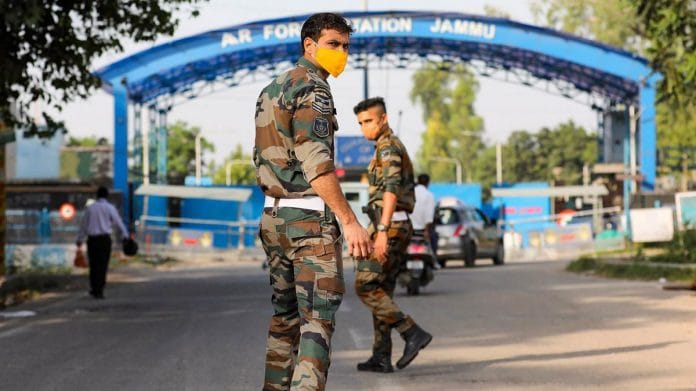New Delhi: The drone attack on the Indian Air Force Station in Jammu is being seen by the government establishments as a display of capability and an attempt to put pressure on the fragile ceasefire being maintained along the Line of Control (LoC) since February, besides disrupting the political process in Kashmir.
Government sources told ThePrint that the drone attack has once again “raised concerns” about the easing of tensions between India and Pakistan, albeit nominal, and relative calm at the LoC.
Prime Minister Narendra Modi held a meeting with Home Minister Amit Shah, Defence Minister Rajnath Singh, and National Security Advisor Ajit Doval Tuesday and discussed “futuristic challenges” in the defence sector.
While the government has not yet come out with an official response on the drone attack that is being investigated by the National Investigation Agency (NIA), all fingers currently point towards Pakistan, the sources said.
This is because agencies believe that the act of flying the drone and retrieving it after dropping the IEDs with impact chargers shows sophistication and planning which regular Over Ground Workers (OGWs) of terror groups in Kashmir cannot have.
In 2019, intelligence inputs had pointed out that the Pakistan-based terror group Lashkar-e-Taiba has been attempting drone-based attacks. The input had then said the terror group was modifying drones to carry a payload of 5 kg.
Also, since last year, Pakistan has been using drones to drop off arms and ammunition into the Indian side to equip the terrorists operating here.
Also read: Nano, micro, small: The different drone types in India & if Jammu-like strike can be averted
Attack days after PM’s meeting with Kashmir leaders
Sources said the attack came days after Prime Minister Narendra Modi’s meeting with Kashmir leaders and is an attempt to put pressure on the fragile ceasefire along the LoC.
“Pressure on the ceasefire agreement is the natural fallout of the attack. There are elements within the Pakistani state who do not want peace. It also comes in the backdrop of an attempt being made to start a new political process in Kashmir. This attack came days after the Prime Minister met with Kashmiri leaders,” a source said when asked about the possible strategic reasons for this attack.
Another source in the security establishment said that the attack was a display of the capability to launch such attacks.
“More than causing any major damage, the attack is a signal by whoever is behind it. The signaling – we can hit you with this now,” the source said.
It is believed that the explosives were of “maximum 3 kg” and both IEDs weighed differently. Clarity would come about only after an analysis report by the forensic team.
Sources also said that the two countries are now also “keeping it all silent” between themselves as both are “cautiously” watching the steps being taken by the US as it winds up its troops from Afghanistan and how the situation evolves there with the gradual mainstreaming of the Taliban.
Also read: Air traffic control, not Mi-17 hangar, could have been actual target in Jammu drone attack
Attack raises strategic concerns
Sharat Sabharwal, the former Indian High Commissioner to Pakistan, said that this attack has caused a lot of concern.
“We have to wait for a word from the government. The ceasefire understanding, which has been in place since February (this year) has largely ensured that there is calm on the LoC. But this incident has disturbed it, somewhat,” he said.
The former High Commissioner added, “We have to see where the investigation goes, the location, the range, etc. If indeed Pakistan’s role comes up then there will be the usual problem of non-state actors or state apparatus behind them. So, we have to wait. There is an investment made into bringing about the ceasefire by both sides, anything dithering it will be a loss compared to what has been achieved”.
The veteran diplomat also cautioned that if such an incident happens again, it will directly “harm the ceasefire on the LoC”.
“The Indian government is trying to start a political process in J&K. Our security people have to draw up robust strategies now. If incidents of this kind continue then it will damage all efforts and potentially harm the start of the peace process … Quieter discussions behind the scenes on sensitive matters are much-needed,” he stressed.
Meanwhile, India Tuesday strongly raised the matter of “use of weaponized drones for terrorist purposes against strategic and commercial assets” even as it called for “serious attention” of the UN.
Speaking at the UN General Assembly, V.S.K. Kaumudi, Special Secretary (Internal Security), Ministry of Home Affairs, said, “Another add-on to existing worries is the use of Drones. Being a low-cost option and easily available, utilization of these aerial/sub-surface platforms for sinister purposes by terrorist groups such as intelligence collection, weapon/explosives delivery and targeted attacks have become an imminent danger and challenge for security agencies worldwide.”
Highlighting that India has put in place an elaborate CT and security architecture, he said, evolving technologies like artificial intelligence, robotics, blockchain, and dark web among others, also pose a security threat to the country now.
Pointing towards Pakistan, he said, “It is high time that the international community calls upon Pakistan to take effective, verifiable and irreversible actions against terror outfits operating on the territory under its control and not take the high road of morality which is only laden with mines of falsehood.”
Also read: Jammu drone attack shows the difficulty of separating Kashmir issue from geopolitics






